Tuesday, 19 June, Cassatt and Rostang
Written 9 July 2018
Tuesday's plan was to go to the Jacquemart-André museum to see their special exhibition on Mary Cassatt. I was expecting it to have a lot of overlap with the Cassatt exhibition we saw in Washington a few Christmases ago, but surprisingly, it didn't.
We got to the museum, as planned, in time for lunch, because they have one of the best lunch rooms around, featuring wonderful salads. The Jacquemart-Andrés, whose house houses and displays their art collection, entertained a lot, so they had quite a large dining room, now the museum's lunch venue (you can get in for lunch without paying the museum's admission fee, so I recommend it as a restaurant in its own right). If you Google "jacquemart-andre cafe," you can see better photos of the room than I could get.

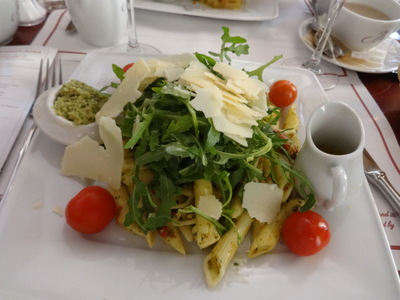 The kitchen was sending out plate after plate of the "plat du jour" and the "quiche du jour," but we always gravitate to the salads, which are named for artists featured in the museum. David ordered the Van Dyke: mixed greens with crisp vegetables and a raspberry dressing, a slice of cold foie gras, sautéed foie gras, nuts, fig toast, fit chutney, and a timbale of caramelized apples.
The kitchen was sending out plate after plate of the "plat du jour" and the "quiche du jour," but we always gravitate to the salads, which are named for artists featured in the museum. David ordered the Van Dyke: mixed greens with crisp vegetables and a raspberry dressing, a slice of cold foie gras, sautéed foie gras, nuts, fig toast, fit chutney, and a timbale of caramelized apples.
I usually order the Vigée-Lebrun (with marinated and smoked salmon, potatoes, and creamy dill dressing), but this time I branched out and tried the Bellini: penne pasta salad with crayfish, feta, sundried tomatoes, cherry tomatoes, parmesan, basil, arugula, green tapenade and a lemon-olive oil sauce. It was great.
They have a dessert trolley laden with pastries and cakes, as well as ice cream, but I think we split a fromage blanc with red fruit coulis.
The Cassatt exhibition was lovely, but alas, no photography was allowed, so I have no images to present here. Until 23 July 2018, though, you can go to the museum's website, click "events," then click on the Cassatt exhibition and "gallery" to get an impression. After that date, you can follow the same procedure but click on "discover past exhibitions" to see the images.
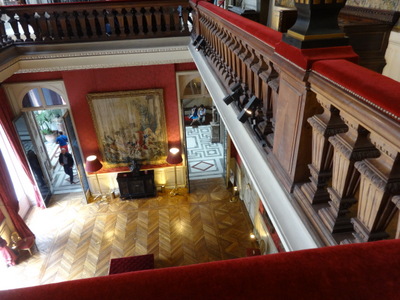
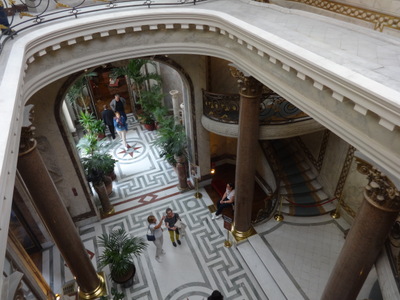 Instead, I can offer some images of the house and the permanent collection, which we've visited many times and took a quick turn through for old times' sake.
Instead, I can offer some images of the house and the permanent collection, which we've visited many times and took a quick turn through for old times' sake.
The Cassatt exhibition was upstairs, so on the way back down, I got these two views. At the left is the view down into the large salon from the musician's gallery. Through the doors at the far end of the salon, you can see the tiled floor of the winter garden.
At the right is the view down into the winter garden from the landing of the double marble staircase (the musician's gallery, which was to my left as I took this photo, runs all the way around the four walls of the salon but offers no way down into it.

 On the wall to my right as I took the last photo is this fresco by Tiepolo of the reception of Henri III of France at the villa Contarini (on his way back from Poland to France to assume the throne after his brother's death).
On the wall to my right as I took the last photo is this fresco by Tiepolo of the reception of Henri III of France at the villa Contarini (on his way back from Poland to France to assume the throne after his brother's death).
At the right is a detail from the lower right corner of the fresco, showing how a piece of the molding has been removed to accommodate the feet of a dwarf court jester, which hand over the edge of the painting, out of the frame.
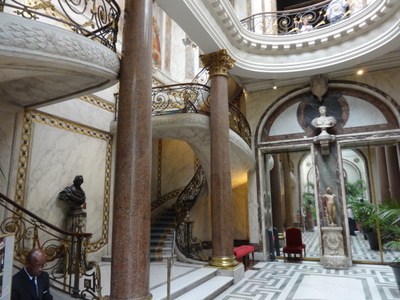
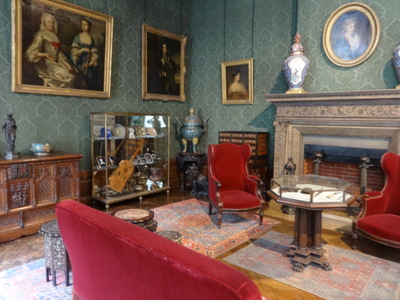 Here's a view of the double staircase from the bottom. The wall I'm facing is a mirror, in which you can see the the reflections of plants (my reflection is hidden by the pilaster in the center with the bust on top, but you can see David's white shirt and white hat, behind me, standing under the winter garden's section of glass roof, admiring the plants).
Here's a view of the double staircase from the bottom. The wall I'm facing is a mirror, in which you can see the the reflections of plants (my reflection is hidden by the pilaster in the center with the bust on top, but you can see David's white shirt and white hat, behind me, standing under the winter garden's section of glass roof, admiring the plants).
At the right is the smaller salon, with travel souvenirs in a glass case and paintings by famous artists (the couple's real travel souvenirs) on the walls. One wall of the larger salon (the one on the right in my view down into it) was mounted on hydraulic lifts so that, for parties, it could be lowered into the basement, and sections of the wall separating the larger and smaller salons could be folded back to widen the doorway between them, essentially opening up the entire ground floor into one large ballroom. They could receive up to 1000 people at a time!
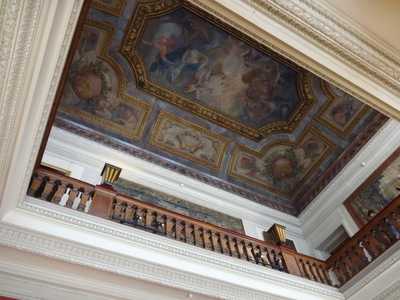
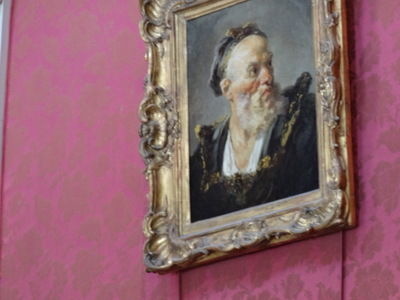 At the left here is a view from the larger salon up through the musician's gallery to the decorative ceiling.
At the left here is a view from the larger salon up through the musician's gallery to the decorative ceiling.
At the right is a portrait that hangs nearby: "head of an old man" by Jean-Honoré Fragonard.
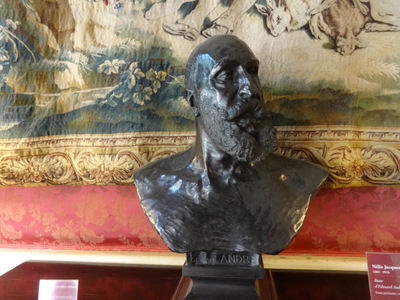
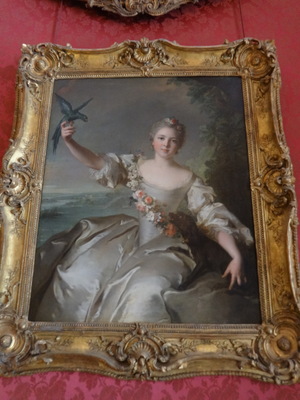 At the left here is an 1890 bust of Edouard André by his wife, Nélie Jacquemart. The two originally met when he commissioned her to paint his portrait (that work now hangs in what was their private sitting room, elsewhere in the house); the bust was made later.
At the left here is an 1890 bust of Edouard André by his wife, Nélie Jacquemart. The two originally met when he commissioned her to paint his portrait (that work now hangs in what was their private sitting room, elsewhere in the house); the bust was made later.
And of course, at the right is our old friend Mathilde de Canisy, marquise d'Antin, painted by Jean-Marc Nattier. A poster of her, souvenir of an earlier visit to this museum, hangs in our living room.
Jacquemart and André were a fascinating couple. Their museum is the very first at which we encounter audioguides, and theirs are still among the most rich and detailed of any we've run into. Almost every entry gives two or three more numbers you can select for more detail about their travels, choice of works, strategy for not competing with French museums, etc. I really recommend this place.
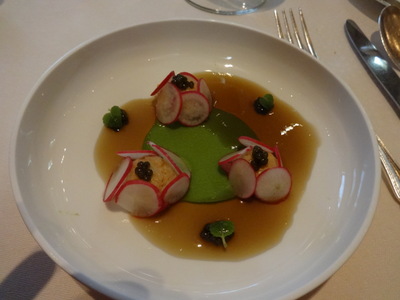
 After the usual period back at the apartment to rest our feet, we set off again for the restaurant David had chosen for the evening: Michel Rostang. Mr. Rostang has long since passed the baton to a younger chef, but Mrs. Rostang keeps the place up to standards. (But why is it that so many restaurants I photograph have these red-and-white temporary traffic barriers set up in front of them?)
After the usual period back at the apartment to rest our feet, we set off again for the restaurant David had chosen for the evening: Michel Rostang. Mr. Rostang has long since passed the baton to a younger chef, but Mrs. Rostang keeps the place up to standards. (But why is it that so many restaurants I photograph have these red-and-white temporary traffic barriers set up in front of them?)
The first amuse bouche was (1) little wedges of cooked beets on garlic mayo on thin toasts, (2) domes of vegetable custard, garnished with pink begonia blossoms, and (3) (already eaten) toasts with sorrel sauce and tiny bits of smoked salmon.
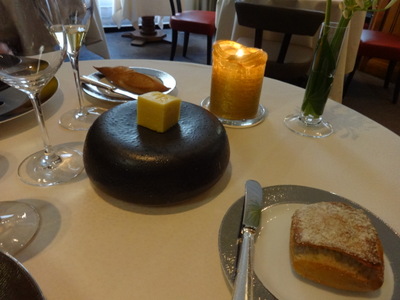
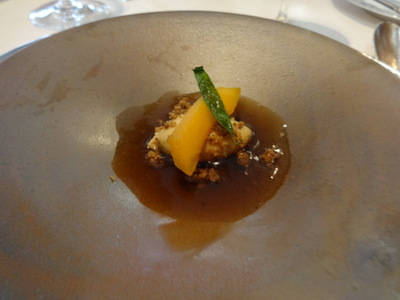 We again ordered the eight-course tasting menu, so we ate the all same things. With the bread (a square "traditional" for me and a pointy-ended miniature baguette for David) came a cube of butter served on a what at first appeared to be a chilled rock but was in fact a chilled hollow pottery thing. The bottom was open.
We again ordered the eight-course tasting menu, so we ate the all same things. With the bread (a square "traditional" for me and a pointy-ended miniature baguette for David) came a cube of butter served on a what at first appeared to be a chilled rock but was in fact a chilled hollow pottery thing. The bottom was open.
After we ordered, we got a second amuse-bouche: a little dish of lobster consomme with a quenelle of something creamy (we thought langoustine, but because the next course was langoustine, that seems unlikely) topped with a sliver of fresh apricot, a tarragon leaf, and a crumble of pine nuts with pain d'épices.

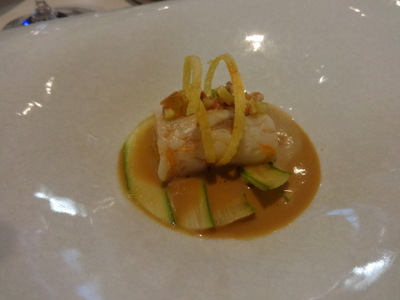 First course: little bites of tourteaux (crab, Cancer pagurus) salad surrounded by infinitessiimally thin slices of radish and topped with dabs of caviar (all the caviar we were served this year was wonderfully mild and tasty). They didn't say what the broth was, so I assume it was also tourteaux. I think the green part was cold pea soup.
First course: little bites of tourteaux (crab, Cancer pagurus) salad surrounded by infinitessiimally thin slices of radish and topped with dabs of caviar (all the caviar we were served this year was wonderfully mild and tasty). They didn't say what the broth was, so I assume it was also tourteaux. I think the green part was cold pea soup.
Second course: Langoustines with green asparagus. The langoustine tails, both cooked ones and raw ones, were rolled into a cylinder, topped with diced preserved lemon, garnished with hoop-shaped cookies, and set in a bouillon made from the langoustine heads.
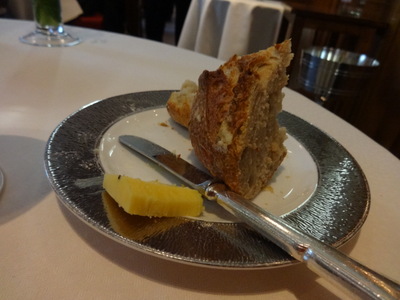
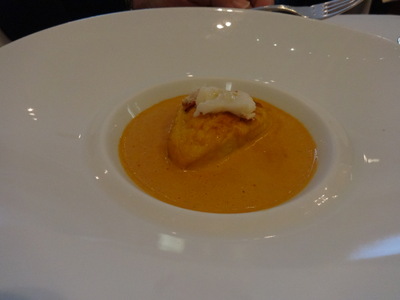 Here's another of the breads we were served.
Here's another of the breads we were served.
Third course: And for my money, among the best of the trip. A quenelle of pike soufléd;ed in lobster sauce. For quenelles, raw fish (usually freshwater pike) is puréed, seasoned, and mixed with cream-puff batter to form a stiffish dough. That dough is shaped into balls, cylinders, or the traditional elongated-football "quenelle" shape and poached in broth just until cooked through. AT that point it can be chilled and stored; this is the form in which you can buy ready-made quenelles in the market. At serving time, as you reheat the quenelles in a rich sauce of your choice, and often sprinkled with cheese, they puff up into little souflés, which you serve piping hot. These were outstanding examples of the dish.
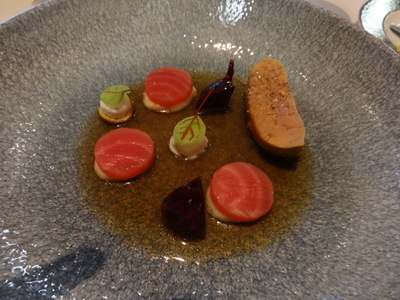
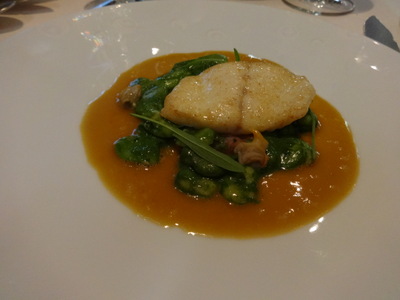 Fourth course: Warm foie gras in a "Corsican broth" with purée of celery root and beets. The oval at 2 o'clock is the foie gras. The dark red objects are wedges of cooked red beet, the green ones are decorative herb leaves topping little dollops of the celery purée, and the ones that look like smoked salmon are actually disks cut from slices of striped chioga beet, also topping celery purée.
Fourth course: Warm foie gras in a "Corsican broth" with purée of celery root and beets. The oval at 2 o'clock is the foie gras. The dark red objects are wedges of cooked red beet, the green ones are decorative herb leaves topping little dollops of the celery purée, and the ones that look like smoked salmon are actually disks cut from slices of striped chioga beet, also topping celery purée.
Fifth course: a slice of roasted turbot served on a ragout of baby fava beans, cockles, and pig's foot, with a sauce made from "yellow wine" (a specialty of the Jura region that David's not fond of to drink but which makes good sauces).
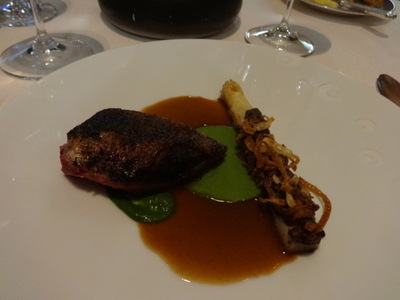
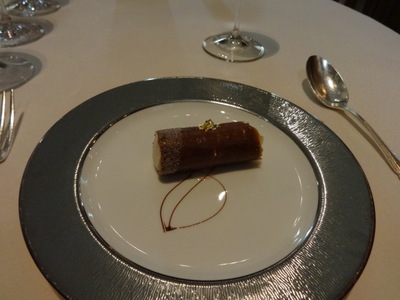 Sixth course: pigeon with white asparagus— a single perfectly rare boneless roasted pigeon breast and a single spear of roasted white asparagus topped with crispy shallots. Two purées of different shades of bright green (spinach? asparagus? pea?).
Sixth course: pigeon with white asparagus— a single perfectly rare boneless roasted pigeon breast and a single spear of roasted white asparagus topped with crispy shallots. Two purées of different shades of bright green (spinach? asparagus? pea?).
Seventh course (first dessert): "The cigar." A cylinder made of crisp cookie (supposedly made from Havana tobacco) filled with Hennessey mousse and Marsala ice cream. Actually very good, once I was able to get that annoying gold foil off the top. On the regular menu, it was listed among the "timeless" desserts, as opposed to the "seasonal" desserts.
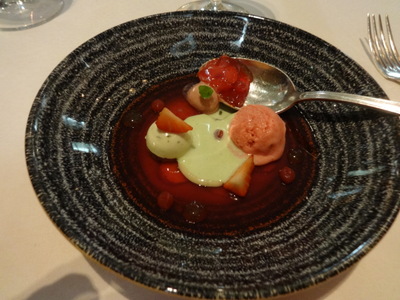
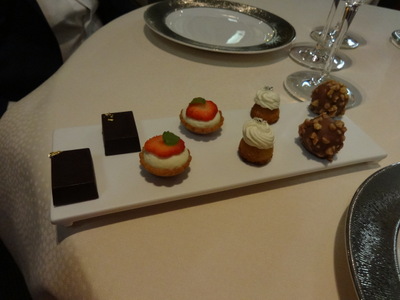 Eighth course (second dessert): Cold jelled strawberry soup with both gariguette strawberries and fraises des bois, topped with strawberry sorbet and tarragon ice cream. Excellent.
Eighth course (second dessert): Cold jelled strawberry soup with both gariguette strawberries and fraises des bois, topped with strawberry sorbet and tarragon ice cream. Excellent.
Mignardises: chocolates, strawberry cream tarts, little cakes with cream on top, and peanut truffles. And gold foil, drat them.
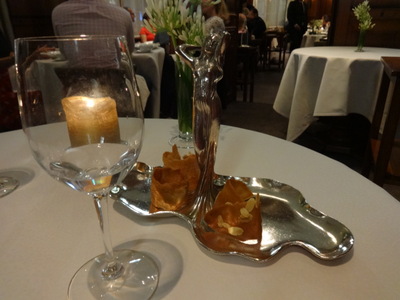 And finally, this handsome silver server bearing two almond tuile cookies (and no gold foil!).
And finally, this handsome silver server bearing two almond tuile cookies (and no gold foil!).
Previous entry
List of Entries
Next entry

 The kitchen was sending out plate after plate of the "plat du jour" and the "quiche du jour," but we always gravitate to the salads, which are named for artists featured in the museum. David ordered the Van Dyke: mixed greens with crisp vegetables and a raspberry dressing, a slice of cold foie gras, sautéed foie gras, nuts, fig toast, fit chutney, and a timbale of caramelized apples.
The kitchen was sending out plate after plate of the "plat du jour" and the "quiche du jour," but we always gravitate to the salads, which are named for artists featured in the museum. David ordered the Van Dyke: mixed greens with crisp vegetables and a raspberry dressing, a slice of cold foie gras, sautéed foie gras, nuts, fig toast, fit chutney, and a timbale of caramelized apples.
 Instead, I can offer some images of the house and the permanent collection, which we've visited many times and took a quick turn through for old times' sake.
Instead, I can offer some images of the house and the permanent collection, which we've visited many times and took a quick turn through for old times' sake.
 On the wall to my right as I took the last photo is this fresco by Tiepolo of the reception of Henri III of France at the villa Contarini (on his way back from Poland to France to assume the throne after his brother's death).
On the wall to my right as I took the last photo is this fresco by Tiepolo of the reception of Henri III of France at the villa Contarini (on his way back from Poland to France to assume the throne after his brother's death).
 Here's a view of the double staircase from the bottom. The wall I'm facing is a mirror, in which you can see the the reflections of plants (my reflection is hidden by the pilaster in the center with the bust on top, but you can see David's white shirt and white hat, behind me, standing under the winter garden's section of glass roof, admiring the plants).
Here's a view of the double staircase from the bottom. The wall I'm facing is a mirror, in which you can see the the reflections of plants (my reflection is hidden by the pilaster in the center with the bust on top, but you can see David's white shirt and white hat, behind me, standing under the winter garden's section of glass roof, admiring the plants).
 At the left here is a view from the larger salon up through the musician's gallery to the decorative ceiling.
At the left here is a view from the larger salon up through the musician's gallery to the decorative ceiling.
 At the left here is an 1890 bust of Edouard André by his wife, Nélie Jacquemart. The two originally met when he commissioned her to paint his portrait (that work now hangs in what was their private sitting room, elsewhere in the house); the bust was made later.
At the left here is an 1890 bust of Edouard André by his wife, Nélie Jacquemart. The two originally met when he commissioned her to paint his portrait (that work now hangs in what was their private sitting room, elsewhere in the house); the bust was made later.
 After the usual period back at the apartment to rest our feet, we set off again for the restaurant David had chosen for the evening: Michel Rostang. Mr. Rostang has long since passed the baton to a younger chef, but Mrs. Rostang keeps the place up to standards. (But why is it that so many restaurants I photograph have these red-and-white temporary traffic barriers set up in front of them?)
After the usual period back at the apartment to rest our feet, we set off again for the restaurant David had chosen for the evening: Michel Rostang. Mr. Rostang has long since passed the baton to a younger chef, but Mrs. Rostang keeps the place up to standards. (But why is it that so many restaurants I photograph have these red-and-white temporary traffic barriers set up in front of them?)
 We again ordered the eight-course tasting menu, so we ate the all same things. With the bread (a square "traditional" for me and a pointy-ended miniature baguette for David) came a cube of butter served on a what at first appeared to be a chilled rock but was in fact a chilled hollow pottery thing. The bottom was open.
We again ordered the eight-course tasting menu, so we ate the all same things. With the bread (a square "traditional" for me and a pointy-ended miniature baguette for David) came a cube of butter served on a what at first appeared to be a chilled rock but was in fact a chilled hollow pottery thing. The bottom was open.
 First course: little bites of tourteaux (crab, Cancer pagurus) salad surrounded by infinitessiimally thin slices of radish and topped with dabs of caviar (all the caviar we were served this year was wonderfully mild and tasty). They didn't say what the broth was, so I assume it was also tourteaux. I think the green part was cold pea soup.
First course: little bites of tourteaux (crab, Cancer pagurus) salad surrounded by infinitessiimally thin slices of radish and topped with dabs of caviar (all the caviar we were served this year was wonderfully mild and tasty). They didn't say what the broth was, so I assume it was also tourteaux. I think the green part was cold pea soup.
 Here's another of the breads we were served.
Here's another of the breads we were served.
 Fourth course: Warm foie gras in a "Corsican broth" with purée of celery root and beets. The oval at 2 o'clock is the foie gras. The dark red objects are wedges of cooked red beet, the green ones are decorative herb leaves topping little dollops of the celery purée, and the ones that look like smoked salmon are actually disks cut from slices of striped chioga beet, also topping celery purée.
Fourth course: Warm foie gras in a "Corsican broth" with purée of celery root and beets. The oval at 2 o'clock is the foie gras. The dark red objects are wedges of cooked red beet, the green ones are decorative herb leaves topping little dollops of the celery purée, and the ones that look like smoked salmon are actually disks cut from slices of striped chioga beet, also topping celery purée.
 Sixth course: pigeon with white asparagus— a single perfectly rare boneless roasted pigeon breast and a single spear of roasted white asparagus topped with crispy shallots. Two purées of different shades of bright green (spinach? asparagus? pea?).
Sixth course: pigeon with white asparagus— a single perfectly rare boneless roasted pigeon breast and a single spear of roasted white asparagus topped with crispy shallots. Two purées of different shades of bright green (spinach? asparagus? pea?).
 Eighth course (second dessert): Cold jelled strawberry soup with both gariguette strawberries and fraises des bois, topped with strawberry sorbet and tarragon ice cream. Excellent.
Eighth course (second dessert): Cold jelled strawberry soup with both gariguette strawberries and fraises des bois, topped with strawberry sorbet and tarragon ice cream. Excellent. And finally, this handsome silver server bearing two almond tuile cookies (and no gold foil!).
And finally, this handsome silver server bearing two almond tuile cookies (and no gold foil!).